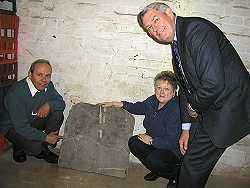
Public Buildings


Pembroke Dock Market
The original walled marketplace, with a central building - the "weighing house" - was completed between 1826-7. At the same time, the Naval authorities
improved Front Street "hard" and Commercial Row. Riverborne traders and customers now had a smooth landing place and road, making their journey to market
easy and inviting.
In the 1850s, the market was so well attended that entertainers and showmen did a thriving trade around the main gate. George Mason lovingly recalls the
scene and characters in Pembroke Street. At Denzy's sweet stall, children could win sticks of rock. "Then John the nut man, with his uneven gun barrel,
requiring a good deal of experience in aiming ... Charley Lock, the razor grinder", surrounded by boys "watching the sparks fly off Charley's grindstone. Long
Joe, the ballad singer, who recounted in song all the events now to be found in daily newspapers; and Manning, the wonderful witty Cheap Jack, whose mobile
face and speech created everlasting laughter ... "
Market regulations, in 1857, were firm. No dogs or carts were permitted within the walls, and the officers could expel anyone causing trouble. The same fate
awaited those "in a state of drunkenness" or anyone rash enough to "smoke tobacco or any other herb" on market premises.
The Corporation bought the market in 1880-1. Traders provided their own stalls in the open market, but "on wet days it suffered through its lack of shelter".
Councillor Thomas Cole suggested that part of the market be roofed. "Naturally", Mason recounts, "such a drastic proposal stirred the town, and a public
meeting was held in the Temperance Hall to discuss the matter". After lively debate, the idea was approved. With the top area roofed in 1886, "trade ...
increased immensely".
A huge roofed hall was now available for events ranging from concerts to mass meetings of
Dockyard trade unionists. The Eisteddfods of of the late 1890s attracted large audiences. The
1905 Eisteddfod was in aid of the hospital, and featured a procession, prize giving and music.
The evening concert was by the Westminster Glee Singers and the orchestra of the King's
Shropshire Light Infantry.
For more official purposes, the market buildings came to house a council chamber, used for the magistrates' court. This room was packed for a 1905 adultery
case. The audience - mostly men - provided regular laughter at the proceedings.
Alderman William Smith was proud that, in World War I, he helped helped organise refreshments and entertainment in the market every night for the soldiers
and sailors who now filled the town. On Sunday evening concerts featured professional entertainers, often watched by "4,000 men enjoying themselves". The
1917 garrison boxing match attracted similar numbers. Recruiting meetings were also held here.
The market housed the fire control point from which Arthur Morris and his crews set out to tackle the blazing oil tanks at Pennar. In 1941 the Market Hall
itself was damaged by blast from a bomb intended for the nearby RAF station.
The building, recently restored to a high standard, continues to house the regular Fridays market.


Public Buildings
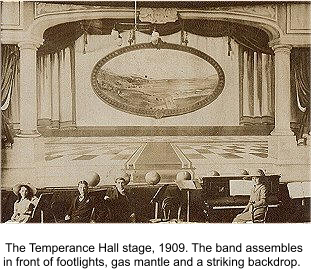
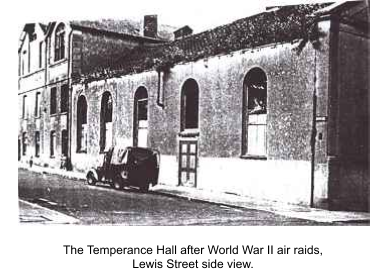
The Temperance Hall (Pater Hall)
The Temperance Hall was built as a non alcoholic social centre for organisations such as the Rechabites' Friendly Society. It offered an alternative to the
town's many inns and public houses.
In 1845, the "earnest and eloquent" speeches of a visiting orator had focused the energies of local temperance supporters, particularly the public spirited
businessman Mr Richard Tregenna. The idea of a Temperance Hall was well received, and two benefactors funded the project.
"The only public hall in town" in the nineteenth century soon became a centre for more general entertainment and events - fundraising concerts and
exhibitions for the Mechanics' Institute, penny readings, lectures, regimental band concerts, and performers ranging from the Pembroke Serenaders to the
visiting "Hoffman's organophonic band". Popular RAF dances were held here before World War II.
Rooms in the block behind the main hall accommodated smaller meetings, such as committees. The monthly County Court, for some time after 1872,
convened at the Temperance Hall.
Early in World War II, during the oil tank blaze, exhausted Bristol firemen were sleeping in the Temperance Hall. Bombers returned, and the hall took a direct
hit. Some firemen were badly injured, but all escaped with their lives. The hall was wrecked. Today's Pater Hall stands on its site, continuing the old hall's
function as a community centre for meetings, entertainment and dances.
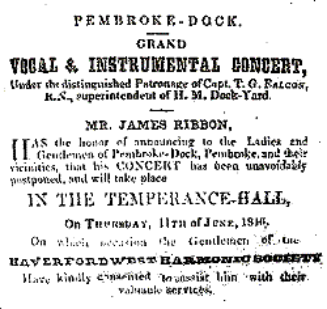
The Temperance Hall has hosted concerts since the 1840s
(as advertised below).
(Sources: Peters 60-62, 48; Armstrong, Tregenna; Evans, Glorious years 50; Scott, Hall died...; Scott, In harm's way 72; PH 22 May 1846)
Pictures courtesy of: - Temperance Hall musicians, Mr Michael Blake - Temperance Hall side view, Pembrokeshire County Libraries - Advertisement: Temperance Hall concert, Pembrokeshire Records
Office - Pater Hall basement, Pembroke Dock Town Council (photograph, Mrs Gwen Griffiths). Moonlightblue Community Services

The 1818 Act of Parliament authorising the Commissioners of
the Navy to "establish a market at the town of Pembroke
Dock" seems, in retrospect, rather optimistic. The planners
had overlooked Pembroke market's ancient privileges. It took
six years' bargaining, and £ 3,000 compensation, before a
competing market was permitted.
In 2014 this plaque was renovated and re-installed in the side of Pater Hall. The ironic thing what was a plaque celebrating the building of a “Temperance Hall”
should now be embedded in the new outside wall of the Pater Hall’s newly installed licensed bar (edit aj)
TOP
HOME
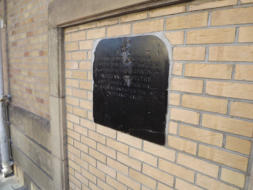
Photo. by Mrs Gwen Griffiths
Deep in the Pater Hall's basement, three
explorers discover a relic salvaged from
wartime rubble.
The text commemorates a benefactor of
the original Temperance Hall.
1872
THIS TABLET WAS ERECTED
BY THE TEMPERANCE SOCIETY,
AS A TOKEN OF THEIR ESTEEM FOR
WILLIAM GRIFFITHS
LATE LESSEE OF THIS HALL,
AND IN REMEMBRANCE OF HIS ZEAL IN THE
TEMPERANCE CAUSE.
(Amendment, updates and additions) (AJ) Anndra Johnstone
This site is designed, published and hosted by CatsWebCom Community Services © 2018 part of Pembroke Dock Web Project

